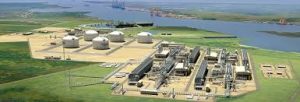
Two years after leaks led federal regulators to shutter a pair of liquefied natural gas storage tanks at Cheniere Energy Inc.’s Sabine Pass export terminal in Louisiana, the company has met fewer than half the conditions for reopening.
The Pipeline and Hazardous Materials Safety Administration (PHMSA) set 16 conditions for reopening the two giant tanks, and Cheniere has completed only five to the agency’s satisfaction. Company officials had said they expected to reopen by the end of last year (Energywire, May 30, 2019), according to Energy Wire.
The process has been shrouded in secrecy. PHMSA won’t say which five conditions have been met. And federal regulators have allowed Cheniere to withhold most details of the repairs as “privileged and confidential.”
Cheniere, which has downplayed the risk of the leaks that spurred the closure, says the duration of the shutdowns is not concerning.
“Analysis and repairs take time, and we will not rush to put a tank back into service,” Cheniere spokeswoman Jenna Palfrey said. “We will bring each tank back into service safely and expeditiously upon approval of our regulators.”
But there have been signs of friction with those regulators.
The terminal, on the banks of Sabine Pass across the water from Port Arthur, Texas, was the first to export LNG, making it a pioneer in the drive to expand the country’s shale gas boom to the world.
The company has been a standard-bearer for a gas export industry that President Trump points to as a key element of his “energy dominance” agenda. Numerous LNG export terminals are being built along the Gulf of Mexico and elsewhere to export the bounty of the country’s shale gas boom, including a second Cheniere facility in Texas.
But the Cheniere leaks raised questions about the safety of those facilities and how they’re being regulated, just as a fleet of new terminals comes online. And the delays cast a shadow on Cheniere’s assurances that the leak problems were minor.
There have also been safety problems at other LNG sites. PHMSA is seeking fines against Kinder Morgan Inc. and Cameron LNG for mishaps at their export facilities.
Kinder Morgan had a confined explosion in 2018 at its plant near Savannah, Ga. (Energywire, Jan. 21). Cameron LNG had a leak at its Hackberry, La., terminal last year the day after Trump visited the site to tout energy exports (Energywire, Aug. 16, 2019).
The cracks were discovered at Sabine Pass on Jan. 22, 2018, when a worker saw a pool of LNG vaporizing in the night air beside one of the storage tanks.
The company secured the area and took the tanks out of service. The exterior shell of the tank had come in contact with the supercooled liquid, making it brittle. The exterior shell had several cracks as long as 6 feet, allowing LNG to spill out.
That created a risk that a cloud of low-lying natural gas could build around the tank and drift until it hit an ignition source and burst into flames. PHMSA investigators showed up two days later and found another tank was leaking vapors from more than a dozen points around its base.
The leaks were not disclosed to the public by federal officials for more than two weeks, until PHMSA issued a public order to shut the tanks down.
LNG tanks have double walls. On newer ones, both walls are built to withstand temperatures below minus 260 degrees Fahrenheit. But at Cheniere’s older facility — originally built for imports — the outer walls are designed to withstand temperatures only down to minus 25 F.
Minor leaks of natural gas from pipelines and other equipment are common and sometimes create the danger of fire or explosion. But liquefying natural gas requires reducing its temperature to below minus 260 F. It must be carefully handled to keep it at that extreme temperature.
Cheniere has repeatedly downplayed the significance of the gas leaks, pointing out they resulted in no injuries, off-site damage or interruptions to commercial operations. But federal regulators have said a leak or explosion could have endangered the public and the 500 workers at the plant.
And federal investigators found more problems as they inquired further. The company acknowledged that four of its five tanks had experienced a total of 28 temperature anomalies since 2009, increasing in frequency after the shift to exports in early 2016. Such cold spots can suggest leaks or insulation problems. But Cheniere didn’t tell regulators until after the 2018 leaks.
PHMSA and the Federal Energy Regulatory Commission have been monitoring the repairs since they were reported. Sharp disagreements between Cheniere and regulators spilled into the open last summer (Energywire, July 10, 2019).
In a series of letters, PHMSA said Cheniere had “failed to comply” with some of regulators’ repair requests, making it necessary to issue the requirements “more formally.” The company shot back that regulators should stick to their “applicable regulatory standards” and heed the advice of “third party experts” (Energywire, July 23, 2019).
PHMSA and FERC laid out 23 requirements in their letter, 16 of which must be done before the terminal can reopen. The company has asked the federal regulators to “close out,” or approve its work on nine of the requirements, including checking the structural integrity of the domes on the two tanks.
Regulators have agreed to Cheniere’s December request to prioritize repairs on one of the two tanks.
But other requirements remain incomplete, as the company hasn’t asked for approval. Among those are including gas monitors on all vents around the tanks and installing corrosion mitigation systems.
Source: E and E News Energy Wire



